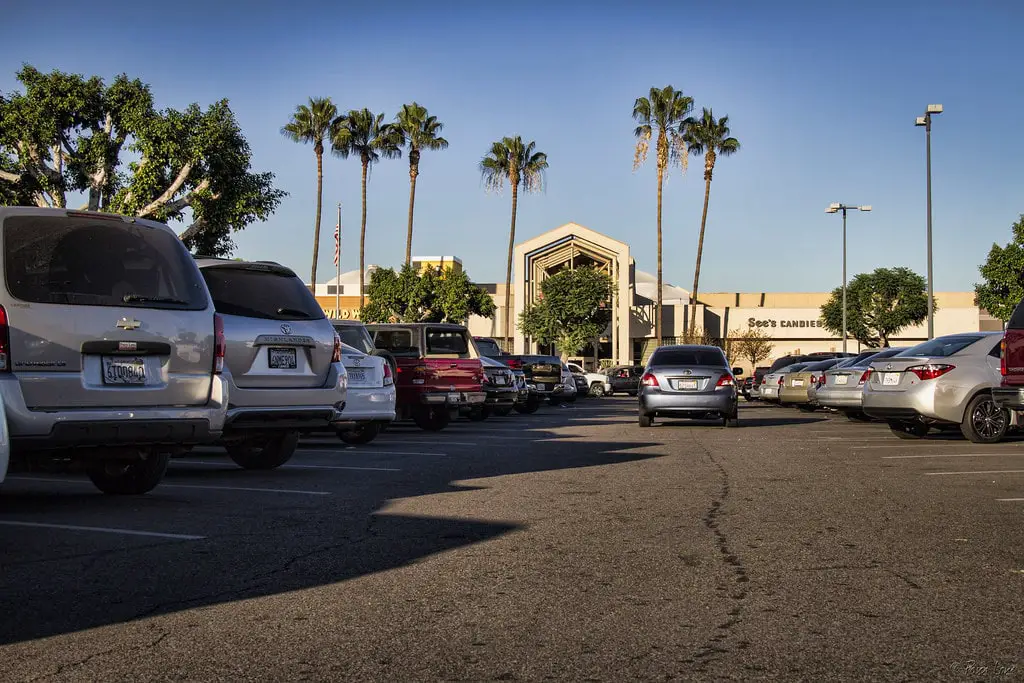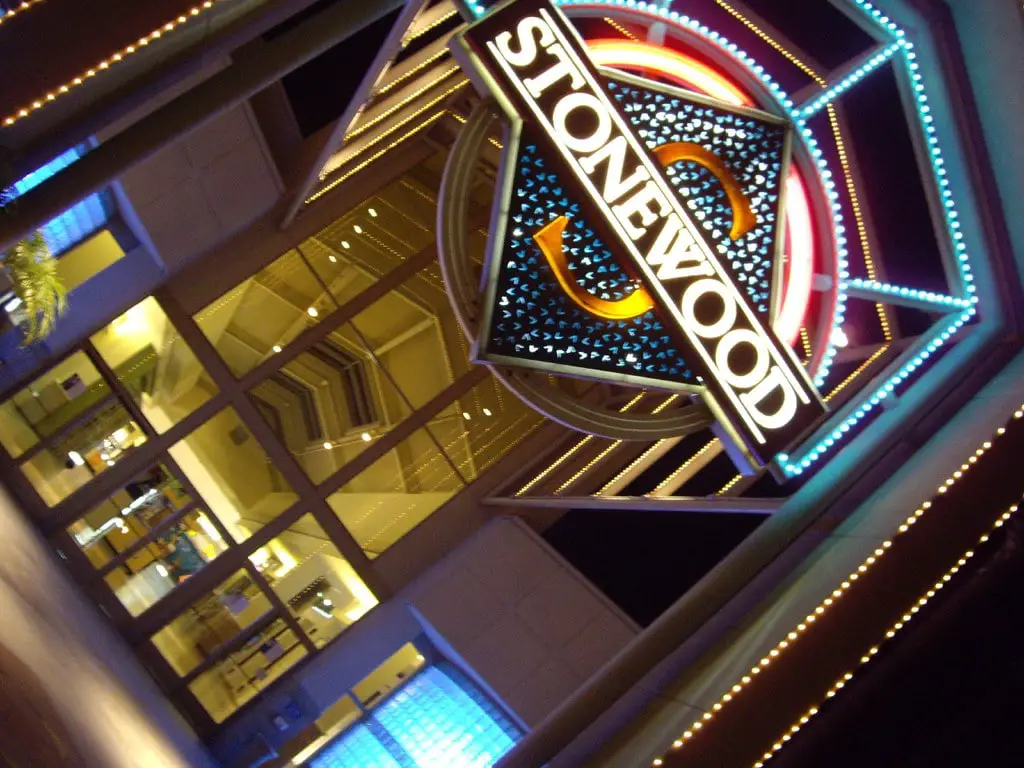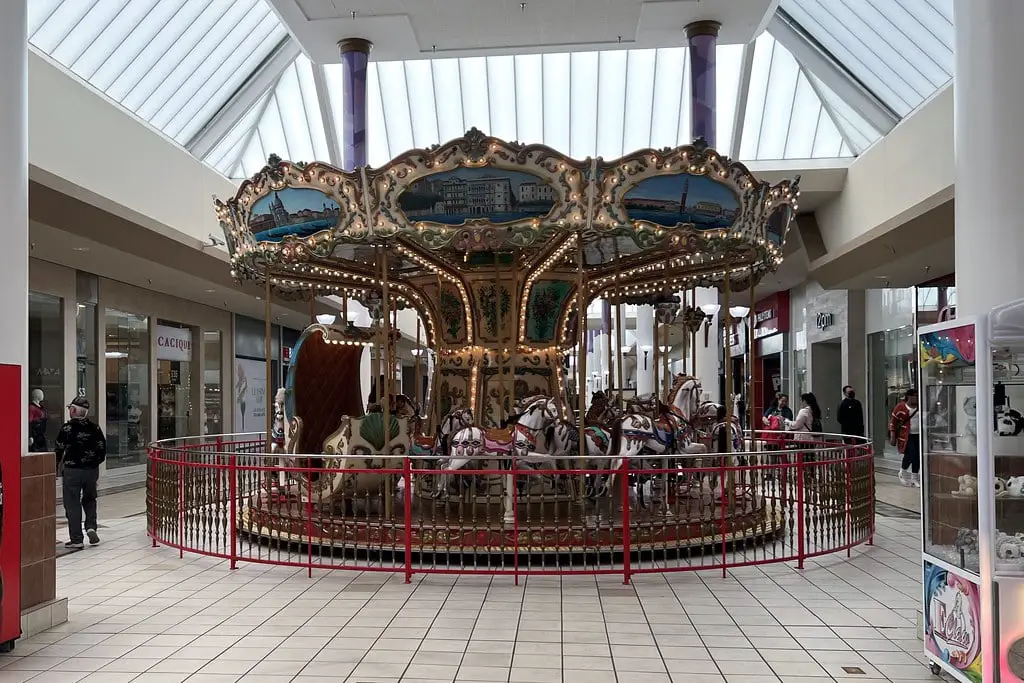Origins and Early Development
Stonewood Center, located in Downey, California, stands on land leased from the Ball Family.
Before the mall's construction, the Ball Family used to farm oranges on this land.
In 1953, William M. Lansdale, a Downey resident, announced plans to establish Downey as a new shopping destination.
Lansdale's vision included building a 63-acre shopping center.
Developer E. Morris Smith from Newport Beach spearheaded the project, working with architects Jacobson, Coppedge & Huxley.
Construction began in late 1957 with a budget ranging from $5 million to $12 million.
The site spanned 62 acres and was initially planned for five buildings with over 60 stores, covering more than 335,000 square feet of gross leasable area.
Before the mall's official opening, the first construction phase included a $750,000 investment in the Stonewood Restaurant, designed by Pereira & Luckman.
This firm also designed the Theme Building at Los Angeles International Airport.
Additionally, Downey Stonewood Community Bank and a 40,000-square-foot Shopping Bag Food Stores opened during this time.
The mall officially opened on October 9, 1958, featuring 40 stores within a larger-than-planned 390,000 square feet of retail space.
Early anchor tenants included J. C. Penney, W. T. Grant, and Woolworth variety stores.
Other notable stores at the opening included Thrifty Drug, Miller, Miller West Men's, Downey Music, and Hollander Cafeteria.
Stonewood Center's early success was due to its location at the intersection of Firestone and Lakewood Boulevards.
This spot provided easy access for shoppers from nearby areas.
Expansion in the 1960s
During the 1960s, Stonewood Center expanded to accommodate growing demand.
In 1965, the Broadway department store opened, adding 143,400 square feet to the mall.
This store became a major anchor, drawing more shoppers.
Farrell's Ice Cream Parlour and Showcase Cinemas were new attractions in the late 1960s.
These additions provided entertainment options, making the mall more than just a shopping destination.
A Radio Shack also opened, catering to the tech enthusiasts of the era.
The mall's expansion continued with the introduction of a twin cinema, which attracted moviegoers and increased foot traffic.
The variety of stores and entertainment options solidified Stonewood Center's position as a go-to place for shopping and leisure.
By the end of the decade, Stonewood Center had grown in both size and popularity.
It adapted to shoppers' changing needs and stayed relevant in a competitive market.
This period of growth set the stage for further developments in the following decades.

Growth in the 1970s and 1980s
In the 1970s, Stonewood Center continued to expand, taking up more of its original land.
By the end of the decade, the mall housed almost 80 stores.
This growth mirrored the broader retail trends of the time, with malls becoming central to suburban shopping experiences.
In 1981, the mall added a two-story Mervyn's store, which later became Kohl's.
This addition boosted the mall's appeal and provided more shopping options.
The 1980s were a period of transformation for Stonewood Center.
In 1986, Hughes Investments purchased the mall, setting the stage for a major redevelopment.
In 1990, Hughes Investments funded a $100-million renovation, turning Stonewood Center into an enclosed mall.
This transformation included over 40 new stores and a new anchor store: a May Company California department store and Acapulco and Olive Garden restaurants.
By the mid-1990s, the mall had almost 940,000 square feet of gross leasable area, reflecting its growth and modernization.
Transformations in the 1990s
The 1990s brought more changes to Stonewood Center. In 1993, May Company rebranded as Robinsons-May, continuing its role as a key anchor store.
These rebrands reflected broader trends in the retail industry, with many department stores merging or changing names.
In 1996, The Broadway closed its branch at Stonewood Center. Sears took over the building, adding a Sears Auto Center in an outparcel.
This change helped maintain the mall's appeal to a broad range of shoppers, from those seeking fashion to those needing automotive services.
By the end of the 1990s, Stonewood Center had firmly established itself as a versatile shopping destination.
The mall's ability to evolve with the times ensured its place in the hearts and habits of local shoppers.

Changes in the 2000s
In the 2000s, Stonewood Center continued to evolve. The decade started with some big changes. In 2006, the Robinsons-May store rebranded as Macy's.
In 2009, Kohl's moved into the former Mervyn's building.
This shift kept the mall's anchor positions filled and ensured that shoppers had a variety of major retail options.
The presence of Kohl's added to the mall's diversity of stores, attracting more shoppers.
Throughout the 2000s, Stonewood Center maintained its appeal by updating its store lineup and incorporating popular retailers.
This period was marked by the introduction of various national chains and specialty stores catering to a wide range of customer preferences.
In September 2021, Sears announced it would close its store at Stonewood Center.
This closure marked the end of an era as Sears had been a staple at the mall for decades.
However, the mall continued to adapt and sought new tenants to fill the space and keep the shopping experience vibrant.
Current Anchors at Stonewood Center
JCPenney
JCPenney has been a cornerstone of Stonewood Center since the mall's early days.
It offers a wide range of products, including clothing, home goods, and accessories.
Over the years, JCPenney has expanded its services to include an optical center, portrait studio, and salon, making it a one-stop shop for many shoppers.
This anchor store consistently attracts a large customer base, contributing to the mall's steady foot traffic.
Macy's
Macy's, another major anchor at Stonewood Center, took over the space from Robinsons-May in 2006.
Macy's brought with it a reputation for quality and variety in fashion, home furnishings, and beauty products.
The store's extensive selection and frequent sales events have made it a popular destination for shoppers looking for both everyday essentials and special occasion items.
Macy's Home section further diversifies the store's offerings, focusing on home decor and furniture.
Kohl's
Kohl's entered the Stonewood Center scene in 2009, replacing the former Mervyn's location.
Known for its wide range of affordable clothing, footwear, and home goods, Kohl's has become a favorite for budget-conscious shoppers.
The addition of Sephora inside Kohl's has also attracted beauty enthusiasts, enhancing the store's appeal.
Kohl's frequent promotions and Kohl's Cash program keep customers returning regularly.

Recent Developments at Stonewood Center (2023 - 2024)
The Button Hole, located behind Stonewood Center, was rededicated on August 30, 2023, to honor residents Wallace C. Button and Harold Tseklenis.
This small passageway allowed Button to continue his daily walks after a wall was built around the mall in 1958.
A plaque commemorating Button was stolen in 2016 and replaced in 2023.
The rededication highlights the community's effort to preserve its unique history and honor the contributions of its residents.
On May 23, 2024, Downey Police Officers responded to a grand theft incident at Mozzafiato Jewelers located within Stonewood Center.
The center has enhanced security measures, including additional surveillance cameras and increased security personnel, to ensure a safe environment for all visitors.
On July 20, 2024, Stonewood Center will host "Stonewood Summer Nights," a vibrant event featuring various food vendors, shopping opportunities, and a kids' zone.
The event aimed to provide an engaging and family-friendly experience for the local community.
Stonewood Center continues to host annual holiday celebrations, drawing large crowds and enhancing the festive spirit in Downey.
Stonewood Center has upgraded its facilities with free Wi-Fi and a mobile app to enhance the shopping experience and support digital engagement for visitors.
The mall actively uses social media platforms like Facebook and TikTok to connect with the community, promote events, and share updates about new store openings and activities.

Thank for sharing the history of the Mall
Thank you for reading! It’s always interesting to learn how places like this have evolved.